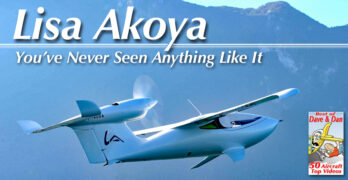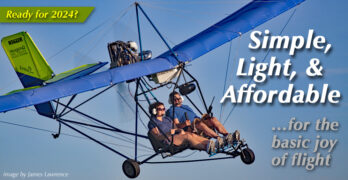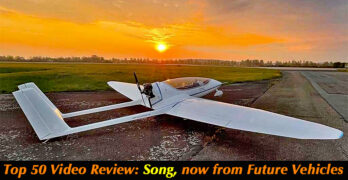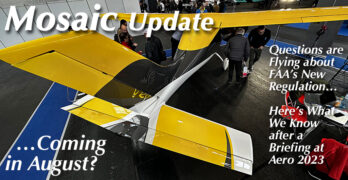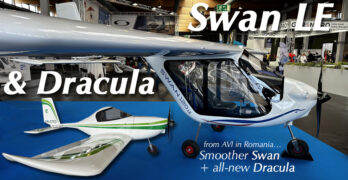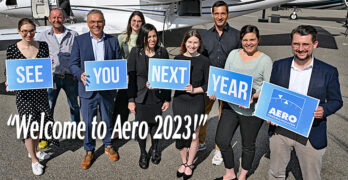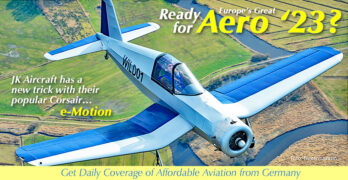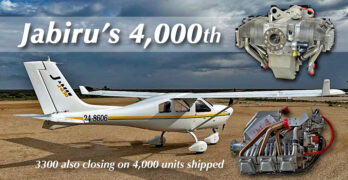“Lisa Akoya: You’ve Never Seen Anything Like It,” trumpeted the lead image. Ten-year-on translation: “You’ve never seen it.”
Inspired design, cutting edge ideas, elegant sleekness, and unique features set the French LSA seaplane apart and may inspire successive designs but Lisa’s Akoya never made it to market.
No wonder,” exclaimed some! More than a decade back, they approached a retail price of $400,000. After ten years of dollar inflation, that number would be way past $500,000 today.
Remarkable as it may be to those of us with normal incomes, buyers for high-end products seem often to emerge. Cirrus and their steady sales of million-dollar-plus four seaters is proof of that. To appeal to such well-heeled pilots, a company better deliver a beautiful, functional, well-supported aircraft. Doing that expertly at a premium level gets expensive.
Here’s Looking at Lisa
Lisa Akoya dates to the very beginning of Light-Sport Aircraft. In 2004, two aviation enthusiasts, Erick Herzberger and Luc Bernole, established Lisa Airplanes in the heart of the French Alps.
Search Results for : electric propulsion
Not finding exactly what you expected? Try our advanced search option.
Select a manufacturer to go straight to all our content about that manufacturer.
Select an aircraft model to go straight to all our content about that model.
Simple, Light, Affordable… Why Recreational Flying Can Soar in 2024
Simple, light, and affordable is not a throwaway line. Each word is pivotal.
Like many of you, I have enjoyed the advancing development of the LSA space, leading to Mosaic LSA in about 15 months. Additional operational capabilities plus features like autopilot, synthetic vision, and powerful, compact engines… all these can build a very exciting airplane.
With Mosaic, the list gets even longer: more weight, more seats, more powerful engines, plus retract, adjustable props, even aerial work for entrepreneurs (see full list). Wonderful, I agree. Some pilots have asked for more and industry with FAA have been working to achieve these potentials.
Yet this is a path to ever-more complex (and expensive) aircraft. Have you been waiting for Mosaic LSA? If yes, your wishes may be answered in 15 months. If not, please continue reading.
Simple, Light, Affordable — All three words are key. Much depends on your aviation goals.
AVI’s Affordable, Foldable, Composite Part 103 Ultralight Aircraft Gets a Fresh New Look
Aeromarine LSA’s Chip Erwin is one but certainly not the only busy fellow in the modern Part 103 aircraft space. AVI’s Radu Berceanu is another a man on the move. Chip works in metal. Radu works in composite. You know Chip better (he’s adept at PR) but you probably know Radu’s designs. Readers have responded enthusiastically to articles and videos about Swan.
In an earlier article I promised a video look. Now that the flying season is easing into the holidays, I have more time to spend editing videos. What takes a few minutes to shoot takes hours to edit but I’m pleased to let you hear from Radu himself. His English is quite good and you get a lot of views of the new & improved Swan, now called Swan LE.
Fresh Swan Retake
The article from April this year had additional detail for Swan LE and mentions Dracula, the subject of a future video and article.
A Song to Lift Your Spirits — Clever, Sleek, and Part 103-Capable from Future Vehicles
You know this airplane and you know this company, although a refresher might be in order.
You can be excused if this one slips you mind. The airplane in the nearby images was from years ago when you probably first saw it with an electric motor developed by Randall Fishman, one of the original pioneers in the electric aircraft space.
He was so far ahead of his time that a market for electric had yet to develop. When Randall flew his first battery-electric-powered trike 16 years ago at Oshkosh 2007, no one was using the terms “air taxi” or “multicopter.”
Electric Aircraft Corporation didn’t complete many sales but Randall’s developments were ground-breaking.
Now the handsome Song returns with a new producer, Future Vehicles. Earlier I wrote about the charming biplane Dingo, a modern-day follow-on to Hovey’s Whing Ding and worthy entry in the Part 103 space.
Air Taxi or Air Funster? — 5 Models in Development, as Part 103 Multicopters Not Taxis
If you listen to perpetually-excited media, air taxis will soon be shuttling people hither and yon in all the big cities of the globe. Executives and shoppers will be whisked around downtown skyscrapers silently, quietly, swiftly, and the cost will be modest. Do you buy all that? I’m not holding my breath.
Oh, these air taxi vehicles are coming. I don’t doubt that, if for no other reason than they are absorbing vast amounts of money as people bet on some grand future where infotech merges with aviation to make flying vastly better and easier. It’s a fantastic dream and when smart people powered by enough money work on something long enough… something often happens.
Fine. That’s the sales pitch and apparently it’s working because more than 350 companies around the globe have raised billions of dollars to pursue their dreams yet the first entries remain far from market.
Several people at the very pinnacle of FAA have departed the agency and are now working for air taxi developers (naturally, they are often called by some term other than the mundane “air taxi” label).
After Spring Airshows, Mosaic Questions Emerge — Here’s What We Know Before FAA’s NPRM Is Released
LAMA, the Light Aircraft Manufacturers Association, hosted a gathering of European manufacturers during last month’s Aero Friedrichshafen show. Van’s Aircraft President and Chief Engineer Rian Johnson accepted LAMA’s invitation and presented an update on Mosaic. As the leader of the ASTM committee working on LSA standards, he covered expected changes to help manufacturers prepare.
How can builders design for a regulation they haven’t seen? Thanks to the use of industry consensus standards, the lighter aircraft industry is more aware than you might expect.
Understandably, manufacturer interest is keen; it’s their business. At the same time, individual pilots increasingly raise similar questions.
Top-Four Questions
I’ll address some common inquiries before getting into specifics of the LAMA meeting. The following reflects questions I’ve often heard, along with my responses. As you read these, remember, I am merely one reporter describing discussions I’ve heard. Disclaimer: Information in this article is not official and may not reflect what FAA is planning.
Aero ’23 Day 3 — AVI Aircraft Impresses Aero with One Major Upgrade and One All-New Design
I found much to discover at Aero Friedrichshafen 2023 but in one exhibit space I found two wonderful surprises. Both are from AVI Aircraft.
One was easy to pick out as new. The other initially fooled me. In the Aero event I missed last year due to Covid (and the prior two years that were cancelled due to government Covid restrictions), AVI developers have been busy.
New from AVI Aircraft
Dracula immediately caught my eye as it did for many Aero attendees. It was new. It was charming. It was sleek. And it still folds up small like its older sibling, Swan. More on that below. Yet Dracula distracted me from Swan, which I thought I already knew. The older model has also been brilliantly renewed.
In addition to dashing lines, especially for a Part 103 ultralight, AVI Aircraft models are affordable. I am aware that word means something different to every pilot, yet in 2023 a ready-to-fly aircraft that looks like Swan in the low $30,000s* may appeal to wide range of budgets.
Aero Friedrichshafen Prepares to Open — Preview as Europe’s Top Show Takes Shape
Aero is open! Yesterday, after flying across the Atlantic and despite starting to run low on energy and affected by the time zone change, a small group of us eagerly took a walk through Aero’s cavernous 12 halls to get a early peek.
As I’ve observed many times, the night before, mere hours ahead of the show opening, the exhibits look chaotic. With packing boxes and parts strewn everywhere it seems impossible vendors can be ready in time. Aside from a few well-heeled organizations — those larger businesses that can pay outsiders to set up their exhibits ahead of time — most companies were scrambling furiously to be ready by opening day… which is now today.
Yet it always works, magically perhaps. Once again, late hours turned into a show by Wednesday the 19th, opening day. The show runs through Saturday the 22d. If you’re in Europe, I hope you’re coming.
Aero Friedrichshafen 2023 — JH Aircraft’s Popular Corsair Debuts e-Motion at Europe’s Best Show
OK, I admit it. I’m a huge fan of Aero Friedrichshafen. This show packs a lot of delight into four days and 12 gymnasium-sized exhibit halls.
In 2023, many of the aircraft on display are known to Americans. However, Europe tends to produce more proof-of-concept projects than we see in America. This is partly as European governments subsidize certain developments, such as when a designer engages a national university. The builder gets technical assistance. The students get real-life experience.
Help with these costs yields many interesting designs but few make it to market. However, novel ideas can find their way into other, marketed designs.
Other projects are carried, just like in America, by entrepreneurs that simply will not stop until they reach their goal. Jörg Hollmann of JH Aircraft is a driven engineer who has steadily developed and improved his super-light Corsair lookalike. For Aero 2023, he has something new… again!
Jabiru Engines Approaching 8,000 Engines Produced — Plus, Our List Reporting Every LSA Engine
When I was a kid, I was a New York Yankees baseball fan. Why? I’d never been to New York; I lived in the midwest. I loved the baseball team because they won a lot. The saying way back then was, “The American League battle isn’t to determine who wins, but which team might come in second.” Everybody knew the Yankees would win again. (As I said, this was some time back in history.)
In light aviation, we have a roughly similar situation. Rotax provides somewhere around 70-80% of all engines for aircraft in the light aircraft space globally. The remaining 20-30% is divided between Continental or Titan, Jabiru, ULPower, and a growing collection of converted auto engines (though the latter, without ASTM approval, are used only on kit aircraft or ELSAs).
US Sport Planes owner Scott Severen, who represents Jabiru in America, declared for the Australian manufacturer, “The 4,000th Jabiru 2200 four-cylinder, 81-horsepower engine [was] recently produced at the Jabiru facility.” And, he added, “The 3300 engine [series is] fast approaching this number, too.”
So, Jabiru may not be #1, but the “down-under” company achieved a significant benchmark when they shipped number 4,000 of the 2200 series.
- « Previous Page
- 1
- …
- 3
- 4
- 5
- 6
- 7
- …
- 13
- Next Page »


